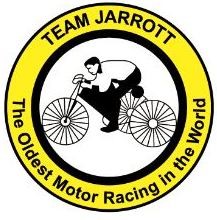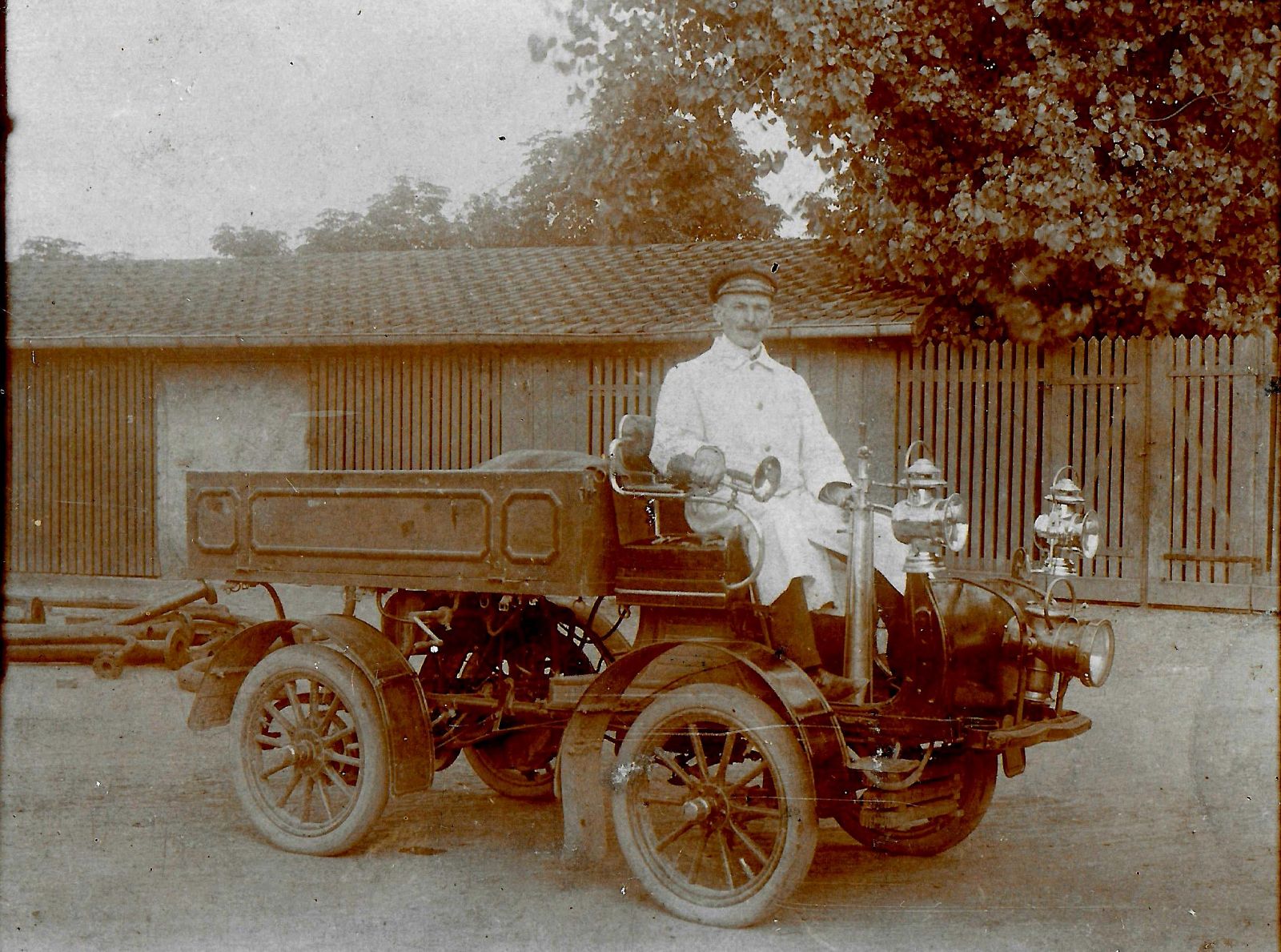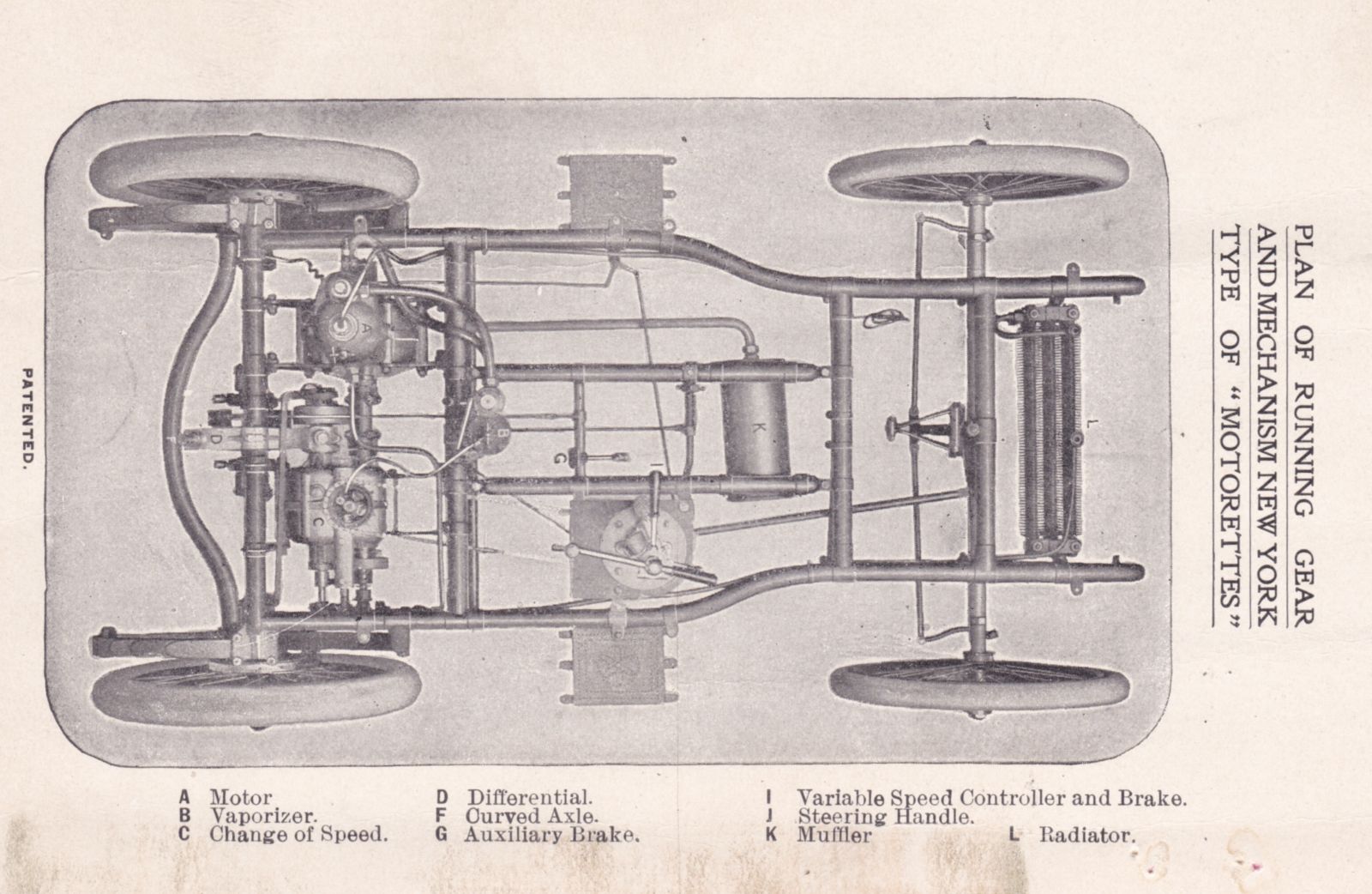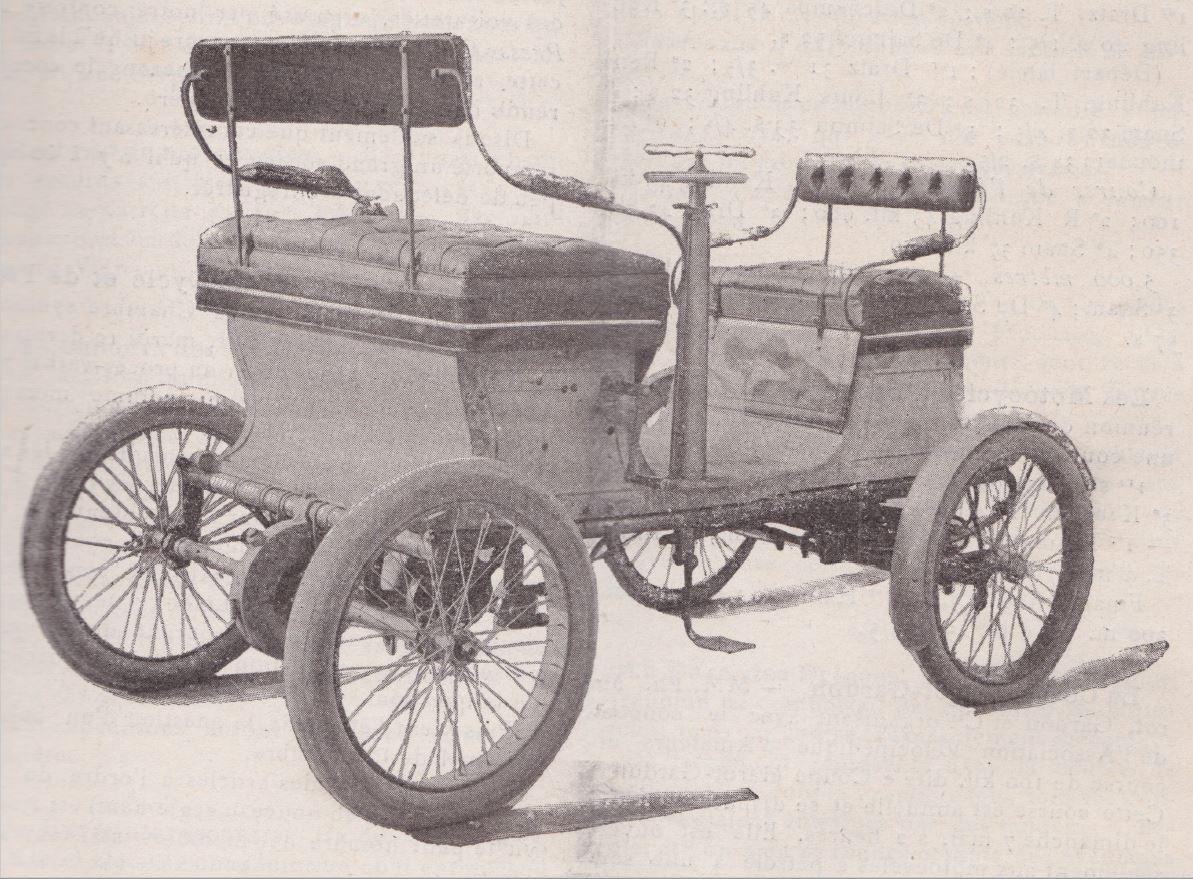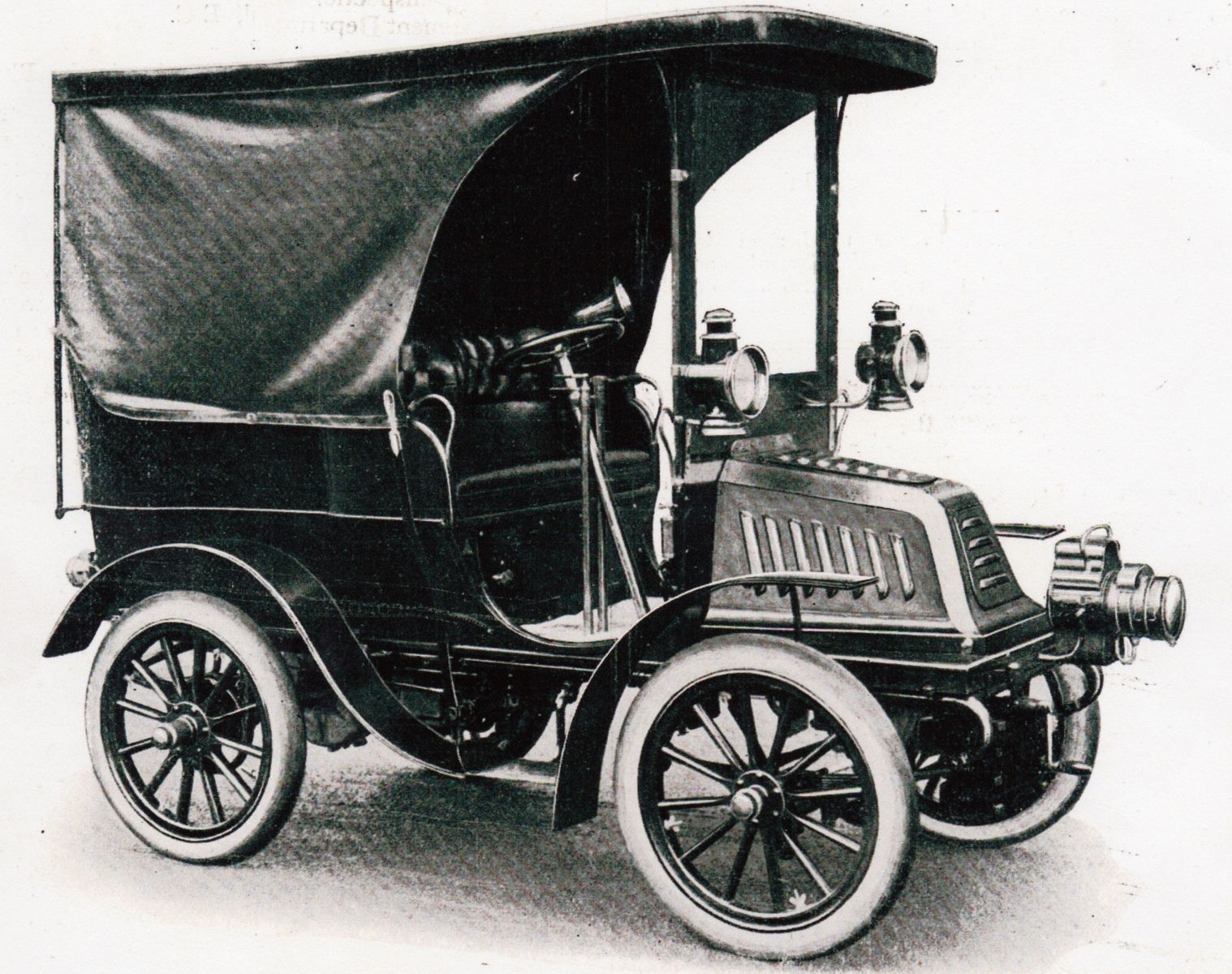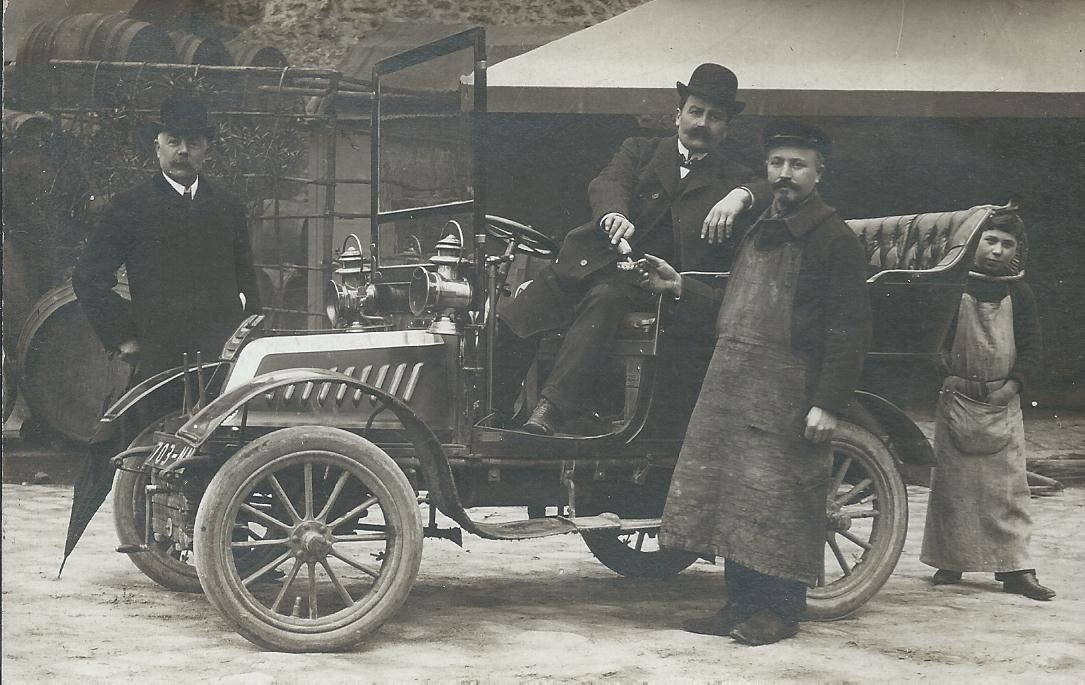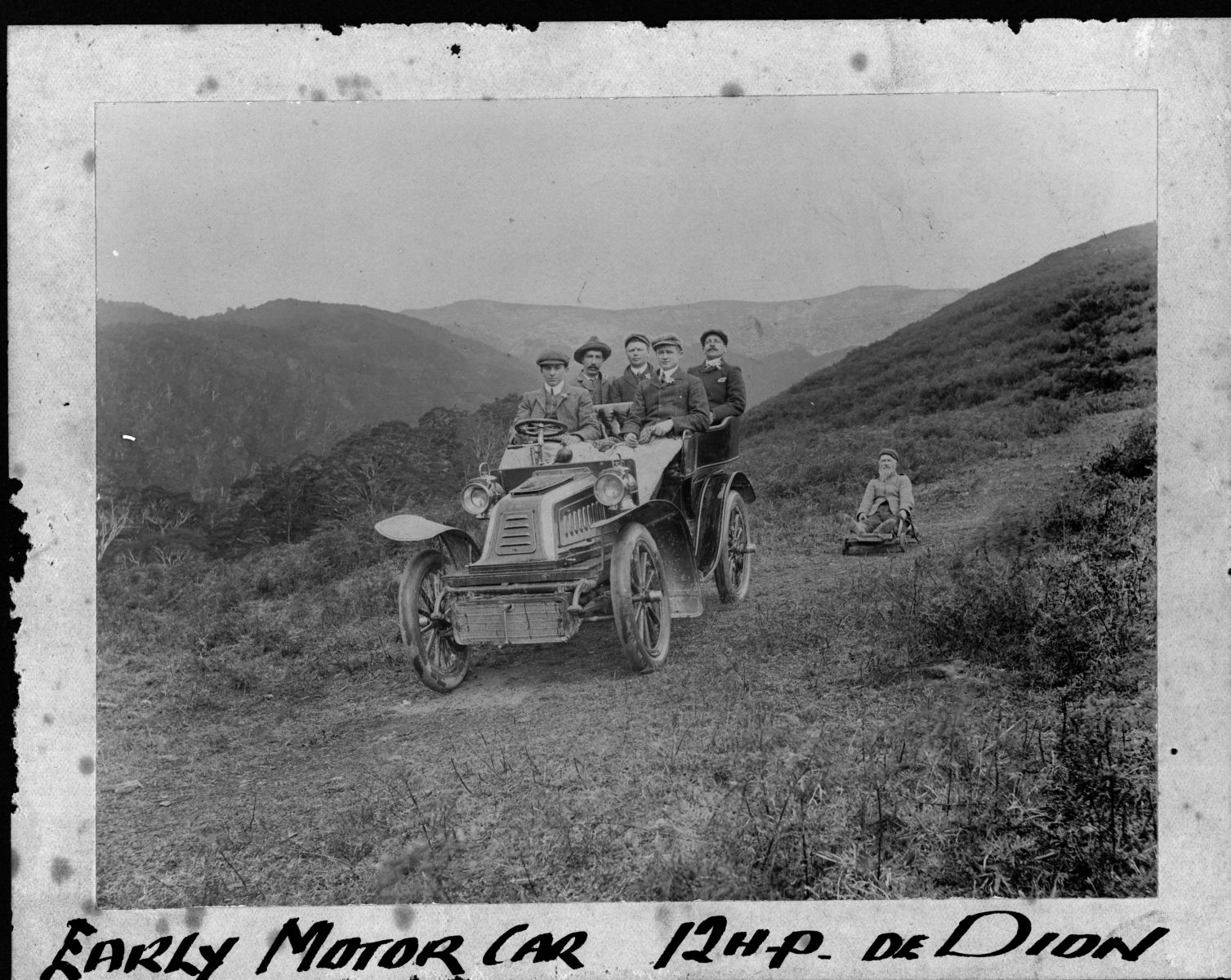Voiturettes
The first four-wheeled vehicles launched by De Dion Bouton were called ‘petites voitures’ in deference to Leon Bolle?e’s registration of the name ‘voiturette’ in 1896, but it is the latter name that has been universally adopted for the Puteaux-produced cars. De Dion Bouton launched its first four-wheeled vehicles in September 1899 following several years of testing various experimental models. The initial production vehicle was a 3.5hp rear-engined model, known as the Type D, which was succeeded by Types E, G and L during the course of three years. It was intended that the Type G would be the final version, but popular demand led to the introduction of the Type L in 1902, with the same 6hp engine as the early front-engined models.
All of the models closely followed the pattern initially established by the Type D, and that itself owed a great deal to the configuration adopted for the quadricycle. These machines had the speed-changing device adjacent to the engine, with the secondary shaft carrying the pinion that transmitted the drive to the crown wheel at one end. This layout, with the gears, clutch and differential gear contained in a compact unit, was chosen for the Type D, and the design of its 3.5hp engine was essentially a larger version of the 2.75hp engine installed in the later tricycles and quadricycles, complete with the identical ignition system attached to the half-time shaft of the engine.
The earliest prototype voiturettes had adequate suspension at the front, with two longitudinally set semi-elliptical springs joined behind the front axle to a third transverse semi-elliptical spring. Rear springs were not provided and the back axle was rigidly attached to the frame tubes, and so little different from the quadricycle, making the roadholding poor, tyre wear high and passenger comfort minimal.
The introduction of the De Dion axle produced a radical solution and addressed all the prevalent issues. In essence, the core mechanical components of engine, gearbox and differential were attached to the chassis with a curved, tubular ‘dead’ axle passing behind. Three-quarter elliptical springs were set between the axle and the chassis, and a pair of universally jointed Cardan shafts, independent of the chassis and axle, carried the power to the wheels.
The voiturette provided comfort in a convivial style for two or more passengers that a tricycle or a quadricycle could not, and it was perfectly capable of long journeys at a speed of 40km/h (25mph). It also offered advantages in cost, operation and maintenance for owner/drivers that vehicles produced by other manufacturers did not. The presence of a light, high-speed petrol engine in a relatively lightweight body influenced many other manufacturers, who adopted similar designs for their own vehicles. A number of tricycle and quadricycle companies had made the decision previously to install De Dion Bouton engines in their frames; the success of the voiturette encouraged many more manufacturers to choose this proven unit.
The Type D voiturette received Type Approval on September 25, 1899. The engine installed had a capacity of 402cc (80mm cylinder bore and stroke), power output of 3.5hp, and a 34mm inlet valve. The water-cooled cylinder was a single casting, and the exhaust port protruded horizontally. Distinguishing features on the original models of this Type included ball bearing wheel hubs, a lack of brakes on the rear wheels, and an unsprung rear axle, although ‘C’ springs were offered as an optional extra. Many extant models have had both brakes and springs installed, for obvious reasons. Speed change is effected through a small wheel under the steering handlebar. There were two brakes: a pedal under the foot acts on the differential, and a pedal under the heel brakes a drum linked to the secondary shaft of the gearbox.
The Type E voiturette received Type Approval on March 27, 1900. The engine was identical in capacity and power output to the Type D, with the same 34mm inlet valve, but its distinguishing feature was the sloping exhaust port. Type E had reinforced ball bearing wheel hubs. There are a number of other features on the Type E that clearly differentiate it from its predecessor. The secondary shaft brake, a feature of the Type D, has been replaced by two rear wheel band brakes, activated by a lever mounted horizontally on the steering column; the same lever controls the clutch engagement of the two-speeds, and replaced the small wheel under the steering handlebar present in the Type D. The heel pedal of the Type D was no longer present. To the rear, three-quarter elliptical springs were set between the axle and the chassis.
The Type G received Type Approval on November 26, 1900. The later Type G examples have so many specific characteristics that set them apart from the early examples that Mortimer-Me?gret, writing in 1904, created unofficial Type G1 and G2 categories that have been widely used subsequently, although the distinction between Type G1 and Type G2 was never formalised through Type Approval with the Service des Mines.
Type G vehicles have the larger 4.5hp engines (84mm cylinder bore and 90mm stroke). The Type G1 models have 34mm inlet valves, the same as their smaller capacity predecessors, but the Type G2 examples have 38mm devices. Type G1 has ball bearing wheel hubs, but the Type G2 has plain bearing wheel hubs of greater length and a pronounced external bulge between the steel spokes, on which is incorporated a Stauffer greaser. New to this model, and a staple of all future engines, is the exhaust valve control situated behind the steering column, which prevents some of the burnt gas escaping. This reduces the size of the next charge, which in turn reduces the engine output. The Type G1 (as with Types D and E) used a separate float-chambered carburettor in which the air intake aperture enlarged as the throttle valve in the induction pipe was opened. A significant camber in the road surface or a steep ascent or descent, however, could easily upset the delicate mixture balance and the advance and retard lever would be called into action. The later carburettor, fitted to the Type G2, had a single chamber that tackled the issue of maintaining the level of petrol constant by introducing a float chamber. The jet sits in the middle of the float, and the level of petrol in the jet never varies relative to the level of the float chamber due to the action of a pivoted forked lever and a weighted needle valve. The Type G1 has a gear type water pump (as with Types D and E), but from the Type G2 onwards, a centrifugal pump, in a large, circular bronze casing, was used. At the heart of the pump is a spindle, on which are mounted four vanes or blades that rotate at speed to pump the water from the water jacket to the radiator.
In 1900 there existed an import tax of 45 per cent on the purchase price of all motor vehicles brought into America, leading to some companies acquiring licences from European motor manufacturers for local production. In early 1900, Kenneth Skinner (who had previously imported tricycles and stationary engines from Puteaux) was granted a licence by the De Dion Bouton Co. to sell and manufacture the company’s vehicles in America, and The De Dion Motorette Co. was established for this purpose. In July 1900 the company’s general manager, Cornelius Field, returned from Paris with three cars, parts and technical drawings.
Individual components attracted a much lower rate of tax and so the engines, HT coils, batteries, contact breakers, oilers and carburettors were all imported in the early days of production. The Motorette company did manufacture its own aluminium gearboxes and all surviving Motorettes have company stamps on the casings. It is often reported, but not known for certain, that the Motorette bodies were assembled by the piano manufacturer Steinway.
The first Motorette vehicles appeared at the Guttenberg Fair in New York in September 1900. It had a 3.5hp engine and fold-down front seats. In 1901, the larger 4.5hp engine was fitted along with heavier springs to cope with the difficult terrain. The business closed in December 1901 following poor reviews of its vehicles and a number of court cases involving unpaid bills. It has been estimated that around 200 vehicles were produced.
The final model to appear was the Type L, which received Type Approval on April 24, 1902, five months after the launch of the first front-engined Type J model, indicating the continuing appeal of the rear-engined vehicles. The Type L is identical to the earlier Type G2 models, with the exception that it now has the larger 6hp (90mm cylinder bore and 110mm stroke) engine with a 38mm inlet valve, identical in capacity to that fitted to the Type J front-engined vehicle. The 6hp engine is physically larger in all respects than its 4.5hp predecessor, requiring some adjustments to the rear engine bay. In particular, the larger crankcase requires that the bearer arms be modified; they are no longer straight, but curved. Amongst voiturettes, curved bearer arms are only evident on Type L vehicles. The rear springs are longer too.
By 1900 the voiturette had proven itself to be reliable and economical, although the vis-a?-vis construct did not lend itself to the needs of all users. The desire to have all four seats facing forward, or an arrangement where there was the opportunity for a load area to the rear, led to the creation of a forward control version. This necessitated a more substantial front part to the chassis, so the two semi-circular dumbirons were removed, to be replaced by a curved hanger fixture for the front spring and a continuous curved tube that connected the two side chassis tubes. The steering column and its linkages were moved from their central location to the front. The result was a nicely balanced vehicle from a weight perspective and elegant double phaeton coachwork was constructed for carrying four passengers. Rather inevitably ,the adaptations of the chassis for commercial purposes were less aesthetically pleasing, and a broad range of enclosed cargo cabins for delivery vans, open platforms for lorry use, and owner adaptations, began to emerge. There were limits, however, to what could be expected from a 4.5hp engine.
Single Cylinder front-engined cars
De Dion Bouton designed 11 single cylinder passenger vehicle models between the summer of 1901 and December 1904. Two of the early models, Types H and I, are best considered as prototypes since only four models were produced. Apparently, they were quite different in appearance from the Type J that appeared in November 1901 since they had vertical rather than raked steering columns, and their engines were the only single cylinder models with an oil pump. These models are referred to in the work of Mortimer-Megret and others, but no illustrations of them have been found by the author.
Despite the innovative overall design of the earliest front engine vehicles produced from the end of 1901, they had similarities with their rear- engined predecessors: many of the constituent parts are slightly modified variants that have been repositioned. The engine is fundamentally the same design, with a progressive increase in power output and efficiency. The gearbox retained its individual expanding clutches, and the rear transmission, water pump, and carburettor are thoroughly reminiscent of earlier produced components.
The chassis throughout the period is of tubular construction, like the voiturette. The layout of the chassis for Types J, K, and O is identical, with its straight tubular side rails, a pair of parallel rails for mounting the engine on, and the steering arm assembly positioned ahead of the front axle. At the front, semi-elliptical front springs were generally used for all models, with the exception of Type K2 and Type O, where a curved-leaf component was added. At the rear there are long semi-elliptical springs over the back axle, shackle-bolted to the main inverted transverse spring. The chassis for Types N, Q, R, V and Y has a waisted (or cranked) layout, wholly different from that of Types J, K, O and V. The engine is mounted on a cross member situated at the narrowest part of the chassis behind the front axle and a set of bearer arms from the parallel rails. At the rear there is three-quarter elliptical springing. The exception to this arrangement is the Type R, which has an inverted transverse spring at the rear.
The gearboxes were of the same overall design in that the casing incorporated the differential mechanism. The early models had a two- speed gearbox, continuing with Types Q and R. The Type O was the first model to have the three-speed gearbox, an arrangement continued with Types V and Y. The design of the dumbirons is a discriminating factor since it varied over the years, gradually evolving from the ‘C’ profile of the Type J to the gently tapered variant from 1903 onwards, which were easier to manufacture and used less metal.
The Type J, launched at the end of December 1901, established the general silhouette and characteristics of all cars that followed: the engine was in front under a tapered ‘coal scuttle’ bonnet; the radiator was forward of the chassis and placed lower than it; the raked steering column was supported by two slender vertical columns that held the controls for ignition, carburation, and clutch. A handbrake operated a band brake on the rear wheels, and a steel drum on the secondary shaft, on which two cast iron jaws tightened. Transmission from engine to gearbox was by a shaft with Cardan joints. The crown wheel was driven by a bevel gear. Transmission from the differential to the wheels was by Cardan shafts engaged in hollow hubs. The centrifugal water pump was uniquely driven from a pinion at the rear of the engine.
The Type K vehicles had two variants. The Type K1 received full Type Approval on February 1, 1902. It is very similar in external appearance to the earlier Type J in terms of wheelbase and track, and the front-end dumbirons. However, under the bonnet there are a number of visible changes. The engine is larger in size (cylinder bore of 100mm and 110mm stroke), and has an increased power output of 8hp and a larger inlet valve of 42mm. It retains the exhaust port at the front of the engine, in common with Type J, and the top bearer arms supporting the engine are straight, whereas in Type J they are very slightly curved. The carburettor is positioned in front of the engine to the offside, and the water pump, smaller in size than the ones provided for the later models, runs off a pinion from the gearbox at the rear of the vehicle.
The K2 model was launched in May 1902 and was essentially promoted as a long wheelbase car. The wheelbase is longer than the Type K1 by 12cm, albeit with the same track of 1.18m. The K2 bonnet is longer than its predecessor, and the extra amount of space in the engine bay in comparison with its predecessors is readily apparent. The engine’s 100mm cylinder bore has been retained, but the stroke has been increased to 120mm, providing increased power. The Type K1 ebonite ignition plate with two terminals has been superseded by a metallic plate with one terminal, although this distinction may not be evident on extant vehicles. The exhaust port is now placed on the nearside of the engine, and an enlarged water pump is placed in front of the engine above the radiator. Both characteristics remain for all subsequent single cylinder models. The primary pinions of the gear-change system and the crown wheel, previously made in bronze for Type K1, are now fashioned from steel.
The Type N light car, sometimes referred to as the first Populaire, and typically with two-seater coachwork, received Type Approval on June 18, 1902. The vehicle is equipped with the same 6hp engine (cylinder bore of 90mm and stroke of 110mm) as the Type J released six months previously, and the same 38mm inlet valve. The essence of the Type N design was simplicity, both in operation and maintenance. It had a gearbox with only two speeds and, given its general suitability for two-seater, lightweight coachwork, a reverse gear was considered to be unnecessary, although an option for a three-speed gearbox did exist. The driver only has one floor pedal. The brake on the secondary shaft of the gearbox has one shoe, instead of the two opposing jaws of the other models.
Apart from the compact size of the Type N, there are several visible characteristics that differentiate the car from its predecessors. For the first time on the front-engined vehicles (but typical of the voiturettes), three- quarter elliptical springs provide suspension to the rear; the underslung kingpins of uniform diameter are replaced with overslung stepped variants, and the steering arms are placed behind the front axle (again emulating the voiturettes). The dumbirons are significantly less rounded than those previously employed.
Type O was the first of the cars planned for 1903, and it received Type Approval on September 9, 1902. With a wheelbase of 1.92m, it had the longest wheelbase of any single cylinder vehicle made up to that point. It has many characteristics in common with Type K2, and the engine bays are almost identical. The two models are differentiated by the gearbox, which in Type O has the extra forward gear as standard (although many Type K2s have retro-fitted Type O gearboxes) and also by the locking lever, absent on the Type K cars. The locking lever sits below the steering wheel and the exhaust valve lifter and comprises a metal quadrant with three notches for different gear combinations. The exhaust valve lifter, controlled by a wooden knob, has the effect when raised of reducing the expulsion of exhaust gas, thereby limiting the volume of air entering the system, which reduces engine power.
Rather unusually during this period of intense development and regular replacement of De Dion Bouton Types, the earlier Type N remained in production for ten months, until it was replaced by the 6hp Type Q, which received Type Approval on April 2, 1903. Even at this point the number of changes that were incorporated into Type Q, which was produced until September 1904, were relatively modest, and included a reverse gear as standard, controlled by means of a pedal placed under the driver’s right heel and a hand pump lubricator with a three-way valve that fed the engine, gearbox and back axle.
The Type R was launched at the same time as the Type Q. The two Types are distinguishable by several features: Type R has the larger 8hp engine, an inverted rear transverse spring, and is the first model where the front wheels have ten spokes and the rear wheels have 12; all earlier models had uniform wheels of 12 spokes each. By the end of 1903, the Type V was available. Designed as the successor to the Type O, it is differentiated by the use of a cylinder head with a separate domed lid, no doubt cheaper to produce and more practical than the previous one-piece cast iron water jacket, and a different design of gearbox.
The aim by 1904 was to enhance the product by offering greater functionality and improved ease of use, while reducing costs and maintaining the price for the customer at a competitive level. The Type Y, available from mid-October, was the first 6hp vehicle to have three forward speeds and a reverse gear as standard. Other improvements were made to enhance the driving experience for the owner of a Type Y. For example, the heel pedal or heel bar previously used to engage reverse (notoriously recalcitrant except at the lowest of engine speeds) was replaced by a side lever that offered better engagement and attempted to design out a flaw in the previous models.
Front-engined twin cylinder cars
The first indication in the British press that the De Dion Bouton company was preparing to produce a twin cylinder vehicle was a full-page advertisement in The Autocar on October 25, 1902. It announced that a 10hp car was to be produced, specifically with the British customers in mind, and orders were being taken. An article subsequently appeared in the French magazine, La Locomotion, in January 1903 and The Autocar magazine in February 1903, announcing the arrival of a new 10hp vehicle from the company. The illustrations that accompanied the reports actually related to components of the 12hp Type S model that received Type Approval on May 18, 1903. It is clear that this particular development had not been without its challenges, and even three months from the submission of the documents for Type Approval, and following circulation of specifications to the prominent motoring journals, the management in Puteaux was still undecided on which particular test engine was going to be put into full production.
The development of the Type S would have required significant investment. It is the case that the chassis layout of twin parallel tubular side rails, the positioning of the steering arm assembly ahead of the front axle, and the long semi-elliptical springs over the back axle, shackle-bolted to the rear transverse spring, were all evident on the earlier Types J, K and O, albeit of more modest dimensions, but the engine and gearbox were entirely new. The engine was of 1782cc capacity, twice that of the single cylinder Type V. Access to the tops of the cylinders was through a separate domed lid on the water jacket, the same as the arrangement for the later Types V and Y single cylinder vehicles. The exhaust outlets emerged from the front and rear of the valve box. A number of features that characterised the single cylinder models were significantly changed. The internal flywheels had been replaced with a single external flywheel. The reliance on splash lubrication was abandoned in favour of a gear pump that drew oil from the bottom of the crank chamber and forced it into the tank at the side of the cylinder from where it ran through the bearings of the motor. The engine incorporated a compression release mechanism that facilitated starting.
De Dion Bouton experimented with different carburettors for its twin cylinder vehicles: at first a single carburettor of the type used with the single cylinder models was tried, but it was found that the irregular suction on the spray from each cylinder caused an unequal mixture, and therefore unequal power. The next step was the use of two separate carburettors, but the difficulty of regulating them so that the level of petrol was the same proved extremely difficult. The solution for the Type S was a carburettor that had two mixing chambers, and one float feed device that served two jets that were controlled simultaneously and to the same extent at all times. A hot-water inlet pipe at the base of the device was designed to promote vaporisation.
The earlier coil ignition made way for ignition by breaker. With this mechanism a blade linked to the primary negative terminal, and so forming part of the earth, alternately comes in contact with two platinum screws linked to the primary positive terminal, and a spark occurs at every separation of blade and screw. The introduction of small cams on the half-time shaft facilitated a slight lift on the exhaust valves on the compression stroke, thereby assisting the starting process.
The three-speed gearbox was of impressive dimensions. In similar fashion to the engine lubrication device, for the first time the Type S device had a gear pump placed in the differential casing, which acted as an oil reservoir. It lubricated all points in the gearbox, and ensured continuous oil circulation in the differential.
L. Baudry de Saunier, writing in La Locomotion in 1903, acknowledged that whilst the Type S was a large vehicle, it was lighter than its competitors, and built for speed and comfort. There was a market for larger vehicles and the Type S chassis and engine choice were designed to accommodate substantially heavier coachwork than its predecessors and offer ample speed.
The 10hp Type W model received Type Approval on September 10, 1903, barely four months after the Type S launch. Whilst the engine of the Type W was comparable to that of its 12hp predecessor in broad design terms, its chassis and gearbox were quite distinct. The Type W chassis had a waisted or cranked layout, wholly different from the Type S, and reminiscent of the design of the lighter Types N, Q, R, V (and subsequent Y). The engine was mounted on a U-shaped tube that was attached to the cross member behind the front axle. As in the Populaire, the steering arm assembly was positioned behind the front axle, a feature that, when combined with the narrower front portion of the chassis, provided an appreciably tighter turning circle than the Type S. There were semi- elliptical springs at the front, and at the rear the semi-elliptical springs were shackle-bolted to an inverse transverse spring, as in the Type S.
The Type W engine shares many of the design characteristics of the larger Type S variant, including the water pump, external flywheel and lubrication mechanism, although on the Type W this has been further improved and the connecting rod bearings are fed with oil from inside by passages drilled in the crankshaft. The Type W engine, however, has a smaller capacity: its cylinders were 90mm bore and 110mm stroke, giving a capacity of 1400cc. There were two variants of the 10hp twin cylinder engine. Three months after the initial Type W Approval Date, De Dion Bouton sought further approval for a revised version of the Type W, which was granted on December 14, 1903. Significant amounts of time and resource were expended in the second half of 1903 reconsidering the early decisions on the twin cylinder project, revisiting the designs, and amending some of the technical details, specifically around engine lubrication and ignition.
It is of interest in this later Type Approval documentation that reference is made to a vehicle with engine number 169B. It is a matter of speculation whether this number represents the total number of 10hp engines made or, indeed, the sum of twin cylinder engines manufactured (including Type S and W) up to this point. In the former case, it would indicate production of 50 units a month and, in the latter scenario, slightly more than 24 a month. Another indication of the limited early Type W production in 1903 is that the publication of detailed technical reviews that would normally accompany a significant launch of a new model are absent in both the French and British motoring press. Numerous references exist to those 10hp vehicles used in trials and appearing at shows, but the first detailed review appeared under the title ‘The Latest De Dion Bouton Petrol Car’ in an edition of The Automotor Journal of March 1904.
While the engine capacity and overall internal design configuration remained unchanged among the two Type W variants, the external appearance changed slightly. With the earlier one, both cylinders were situated in a single cast housing, which was only joined at the top, and the bases were separate. With the second variant of the Type W model, available from mid-December 1903, the two cylinders are joined along their entire height, as with the Type S, thereby promoting rigidity and more efficient cooling. The single blade ignition system that was first used with the Type S continued with the first and second variants of the Type W, but in May 1904 it was replaced with a twin blade one. The purpose behind the change was to increase efficiency so that the incidence of a ‘redundant spark’ was removed and in effect each cylinder received its own spark at the right time.
The Type W gearbox provides for three forward speeds and reverse, but is quite different from that of the Type S in both size and construction, and virtually identical to that of the earlier Type O, except that the ratios were somewhat modified and the plain rear bearing on the primary shaft was replaced by a ball bearing. There is no forced lubrication. The control of the sliding pinion and the reverse is new and unlike that of the Type O in that the sliding pinion is controlled by a lever placed on the right of the driver; the hand grip of this lever can pivot when it is placed in the clutch notch, and this rocking movement controls the rocking of the reverse pinion. Also, the clutch lever that was placed previously on the left of the steering is now on the right in this Type, so that the driver has under his right hand all the controls for the clutch, gear change and drive.
The twin cylinder vehicles were designed to appeal to a very select but limited market. In February 1904, a Type Q two-seater-bodied vehicle made in England would cost a customer £245, with additional costs of around £30 for a windscreen and other accessories. The cheapest English- bodied Type W vehicle was set at £465, which would increase once the extra items had been installed; a popular option was the tonneau with a detachable top, which had a price tag of £540. If the purchaser were to select a Type S landaulet on a long frame chassis, the basic cost rose to £700, and with the essential accessories in place, a final cost of £800 was possible.


